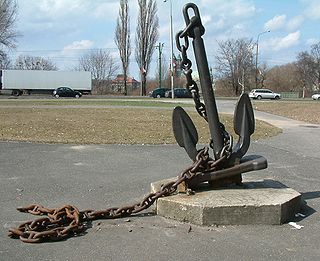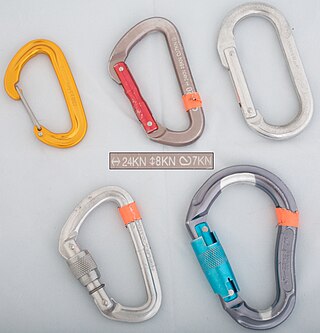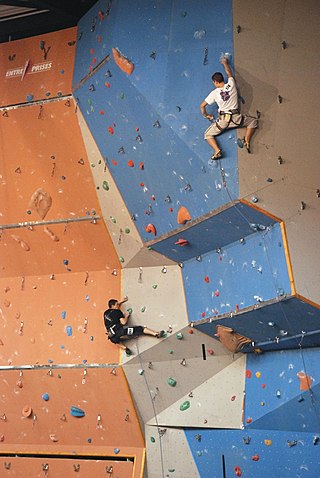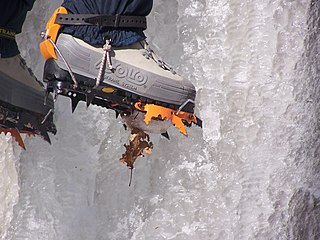
An anchor is a device, normally made of metal, used to secure a vessel to the bed of a body of water to prevent the craft from drifting due to wind or current. The word derives from Latin ancora, which itself comes from the Greek ἄγκυρα.

A carabiner or karabiner, often shortened to biner or to crab, colloquially known as (climbing) clip, is a specialized type of shackle, a metal loop with a spring-loaded gate used to quickly and reversibly connect components, most notably in safety-critical systems. The word is a shortened form of Karabinerhaken, a German phrase for a "carbine rifle hook" used by a carbine rifleman, or carabinier, to attach his carbine to a belt or bandolier.

Mountaineering, mountain climbing, or alpinism is a set of outdoor activities that involves ascending mountains. Mountaineering-related activities include traditional outdoor climbing, skiing, and traversing via ferratas that have become sports in their own right. Indoor climbing, sport climbing, and bouldering are also considered variants of mountaineering by some, but are part of a wide group of mountain sports.

A climbing wall is an artificially constructed wall with grips for hands and feet, usually used for indoor climbing, but sometimes located outdoors. Some are brick or wooden constructions, but on most modern walls, the material most often used is a thick multiplex board with holes drilled into it. Recently, manufactured steel and aluminium have also been used. The wall may have places to attach belay ropes, but may also be used to practice lead climbing or bouldering.

Snowshoes are specialized outdoor gear for walking over snow. Their large footprint spreads the user's weight out and allows them to travel largely on top of rather than through snow. Adjustable bindings attach them to appropriate winter footwear.

The Washington Monument is an obelisk on the National Mall in Washington, D.C., built to commemorate George Washington, a Founding Father of the United States, victorious commander-in-chief of the Continental Army from 1775 to 1783 in the American Revolutionary War, and the first President of the United States from 1789 to 1797. Standing east of the Reflecting Pool and the Lincoln Memorial, the monument, made of marble, granite, and bluestone gneiss, is both the world's tallest predominantly stone structure and the world's tallest obelisk, standing 554 feet 7+11⁄32 inches (169.046 m) tall, according to the U.S. Geodetic Survey measurements in 2013–2014. It is the tallest monumental column in the world if all are measured above their pedestrian entrances. It was the world's tallest structure between 1884 and 1889, after which it was overtaken by the Eiffel Tower, in Paris. Previously, the tallest structure was the Cologne Cathedral.

A crampon is a traction device attached to footwear to improve mobility on snow and ice during ice climbing. Besides ice climbing, crampons are also used for secure travel on snow and ice, such as crossing glaciers, snowfields and icefields, ascending snow slopes, and scaling ice-covered rock.

An ice axe is a multi-purpose hiking and climbing tool used by mountaineers in both the ascent and descent of routes that involve snow, ice, or frozen conditions. Its use depends on the terrain: in its simplest role it is used like a walking stick, with the mountaineer holding the head in the center of their uphill hand. On steep terrain it is swung by its handle and embedded in snow or ice for security and an aid to traction. It can also be buried pick down, the rope tied around the shaft to form a secure anchor on which to bring up a second climber, or buried vertically to form a stomp belay. The adze is used to cut footholds, as well as scoop out compacted snow to bury the axe as a belay anchor.

Glossary of climbing terms relates to rock climbing, mountaineering, and to ice climbing.

Ice climbing is a climbing discipline which involves ascending routes that consist only of frozen water. To ascend the route, the ice climber uses specialist equipment, particularly double ice axes and rigid crampons. To protect the route, the ice climber uses steel ice screws that require skill to employ safely and rely on the ice holding firm in any fall. Ice climbing routes can vary significantly by type, and include seasonally frozen waterfalls, high permanently frozen alpine couloirs, and large hanging icicles.

Rock-climbing equipment varies with the type of climbing undertaken. Bouldering needs the least equipment outside of shoes and chalk and optional crash pads. Sport climbing adds ropes, harnesses, belay devices, and quickdraws to clip into pre-drilled bolts. Traditional climbing adds the need for carrying a "rack" of temporary passive and active protection devices. Multi-pitch climbing adds devices to assist in ascending and descending fixed ropes. And finally aid climbing uses unique equipment.

Ski mountaineering is a skiing discipline that involves climbing mountains either on skis or carrying them, depending on the steepness of the ascent, and then descending on skis. There are two major categories of equipment used, free-heel Telemark skis and skis based on Alpine skis, where the heel is free for ascents, but is fixed during descent. The discipline may be practiced recreationally or as a competitive sport.

In rock climbing, a nut is a metal wedge threaded on a wire that climbers use for protection by wedging it into a crack in the rock. Quickdraws are clipped to the nut wire by the ascending climber and the rope threads through the quickdraw. Nuts come in a variety of sizes and styles, and several different brands are made by competing manufacturers. Most nuts are made of aluminum. Larger nuts may be threaded on Dyneema cord instead of wire, but this has become unusual.

Rock climbing is a sport in which participants climb up, across, or down natural rock formations or indoor climbing walls. The goal is to reach the summit of a formation or the endpoint of a usually pre-defined route without falling. Rock climbing is a physically and mentally demanding sport, one that often tests a climber's strength, endurance, agility and balance along with mental control. Knowledge of proper climbing techniques and the use of specialized climbing equipment is crucial for the safe completion of routes.

Hiking (walking) boots are footwear specifically designed for protecting the feet and ankles during outdoor walking activities such as hiking. They are one of the most important items of hiking gear, since their quality and durability can determine a hiker's ability to walk long distances without injury. Hiking boots are constructed to provide comfort for walking considerable distance over rough terrain. Boots that protect the hiker's feet and heel are recommended. Hiking boots give ankle support and are fairly stiff. A less popular alternative is to use light trainers with thin soles. Footwear should be neither too loose nor too tight, to help prevent blisters and sore feet. Hiking socks that wick sweat from the feet, provide warmth, and cushion the feet are recommended and a thin, inner sock may also help. Most hiking boots are also designed for other outdoor activities such as backpacking, climbing, mountaineering, and hunting.
In rock climbing, an anchor can be any device or method for attaching a climber, a rope, or a load above or onto a climbing surface—typically rock, ice, steep dirt, or a building—either permanently or temporarily. The intention of an anchor is case-specific but is usually for fall protection, primarily fall arrest and fall restraint. Climbing anchors are also used for hoisting, holding static loads, or redirecting a rope.
Mountaineering, expedition or high altitude boots are a type of footwear used in mountain climbing. They are designed specifically for moving over harsh terrain.

An ice screw is a threaded tubular screw used as a running belay or anchor by climbers on steep ice surface such as steep waterfall ice or alpine ice during ice climbing or crevasse rescue, to hold the climber in the event of a fall, and at belays as anchor points.

An ice tool is a specialized elaboration of the modern ice axe, used in ice climbing, mostly for the more difficult configurations. Ice tools are used two to a person for the duration of a pitch, and thus in some circumstances such as top-rope-anchored climbs, a pair may be shared among two or more people, where only one of them at a time is climbing. In contrast a classical "ice axe" is used one to a person for the hours or days a party is traveling across snow or glacier. In communities where it is common to refer to an "ice tool" simply as an "ice axe", classic "ice axes" are often referred to as "traveling axes", "walking axes", or "general mountaineering axes" to distinguish them from "tools".
Deadman or Deadman's may refer to:


















